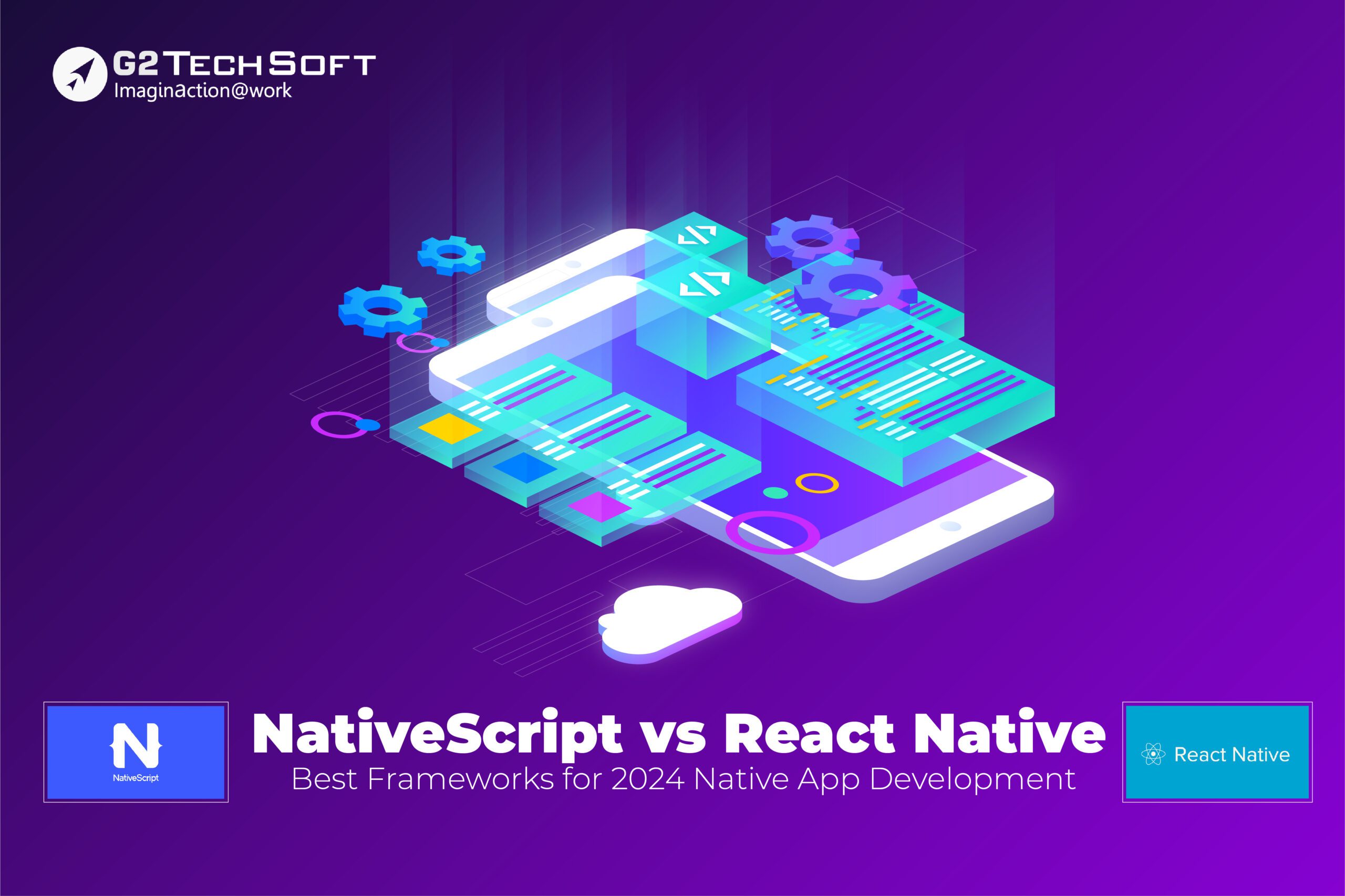
NativeScript vs React Native: Best Frameworks For 2024 Native App Development
For a long time, native mobile apps, developed in specific languages like Java for Android and Swift for iOS, dominated digital platforms due to their seamless native API access and optimized performance. However, they are costly and time-consuming as they require separate codebases for different platforms.
In contrast, mobile web apps, built with CSS, HTML, and JavaScript, offer unified development and easier updates. Despite limitations in accessing native features, technologies like NativeScript and React Native allow natively rendered apps using JavaScript, combining the benefits of both native and web apps. Businesses should choose top development vendors to effectively leverage these technologies.
NativeScript vs. React Native And Its Advantages For Modern App Development:
NativeScript:
NativeScript simplifies mobile app development by using familiar web technologies like TypeScript, JavaScript, and CSS, permitting seamless code deployment on both Android and iOS with a native look and feel. It compiles JavaScript into native code for better performance and supports popular frameworks like Vue.js, Angular, and React, with pre-built UI components for easy integration. NativeScript empowers developers to create powerful mobile apps without needing extensive expertise in app development.
Advantages:
- Direct access to native APIs for enhanced performance.
- Native UI components for a natural look and feel.
- User-friendly for novices with limited platform-specific language experience.
- Supports Angular and Vue.js, leveraging existing skills effectively.
React Native:
React Native uses React and JavaScript to create native apps for both iOS and Android, permitting developers to build apps with a single codebase. Unlike web apps, React Native generates native apps that can use device features like the camera and GPS.
Developers familiar with React can easily make the transition to mobile development, saving time and effort. React Native promotes code reuse between platforms, enhancing productivity. It offers a powerful solution for cross-platform mobile development with native performance and a familiar development experience.
Advantages:
- A robust and engaged community providing ample resources, tutorials, and support.
- A smoother learning curve, especially for developers already familiar with JavaScript and React.
- The hot reloading feature accelerates development by showing changes in real time without restarting the app.
- Streamlines development with access to an extensive array of third-party libraries and components.
Exploring Essential Features: React Native and NativeScript for Cross-Platform App Development
React Native:
- Native UI Components: React Native permits developers to create UI components that render as native views on the underlying platform, ensuring a truly native look and feel.
- Code Reusability: Developers can reuse code across Android and iOS, writing the business logic once in JavaScript and sharing it across both platforms.
- Fast Refresh: The Fast Refresh feature lets developers see changes immediately without a full rebuild, enhancing development productivity.
- Vibrant Ecosystem: With a large, active community and a vast ecosystem of third-party libraries and plugins available on platforms like npm, React Native is well-supported.
- Backed by Meta (Facebook): Originally developed and actively maintained by Meta (formerly Facebook), React Native benefits from strong vendor support and reliability.
NativeScript:
- Native API Access: NativeScript provides direct access to native Android and iOS APIs, permitting developers to fully leverage the platform’s capabilities.
- Flexible Framework Support: It supports multiple frameworks, including Vue.js, Angular, and Svelte, making it versatile for developers with different technology preferences.
- NativeScript Marketplace: The official marketplace for NativeScript offers a centralized, curated source for plugins and extensions, enhancing functionality.
- Hassle-Free Native Development: NativeScript simplifies native API access without the need for complex bridging, making it easier for developers without extensive native platform knowledge.
- Performance Advantages: NativeScript’s single-threaded architecture can provide faster startup times compared to React Native’s multi-threaded approach, particularly for certain applications.
Choosing Between NativeScript And React Native For Your App Development Needs:
Learning Curve:
Both NativeScript and React Native are JavaScript-based mobile development frameworks, making them accessible to developers with JavaScript experience. Developers familiar with Angular will find NativeScript easier due to its integration with the Angular CLI and support features.
Similarly, developers experienced with React can transition smoothly to React Native. Both frameworks support TypeScript, offering advanced JavaScript features, and Flow, a static type-checking library. React Native defaults to using Flow, while NativeScript defaults to TypeScript, but this can be changed.
Development Tools:
NativeScript uses Angular or Vue.js for building user interfaces, which are ideal for mobile development due to their lightweight nature. Switching from Vue.js to NativeScript-Vue involves minor changes in setup and template syntax. React Native uses Flexbox for layout, similar to CSS, but styles are declared in JavaScript objects. Both frameworks can be debugged using Chrome Developer Tools.
React Native developers can also use React Native Debugger and Reactotron, while NativeScript developers might use the Visual Studio Code NativeScript extension. Debugging with XCode is possible for both technologies.
Third-Party Plugins:
NativeScript and React Native allow access to native Android and iOS APIs via JavaScript. NativeScript enables direct access to all APIs without boilerplate wrappers and offers many pre-built plugins on the NativeScript Marketplace.
React Native lacks a specialized marketplace but extends built-in components via the npm registry. Developers can write native code using native modules, but React Native’s built-in capabilities often suffice.
Performance:
NativeScript uses a single-threaded model for fast native API access, while React Native employs a multi-threaded architecture, separating JavaScript and UI threads to prevent interference.
NativeScript’s UI can freeze with intensive JavaScript processing but benefits from Google’s V8 engine on Android for better startup performance. React Native uses Apple’s JavaScriptCore on iOS and Hermes on Android. Overall, their performance is comparable, with specific strengths in certain areas.
Community:
React Native is more prominent than NativeScript, with significantly higher downloads and GitHub stars. React Native benefits from strong backing from Facebook, making it a trusted choice for large enterprises. NativeScript, supported by Progress, continues to improve but lacks extensive marketing.
NativeScript vs React Native: Deep Dive Into A Comparative Evaluation
Engine Performance:
NativeScript uses the V8 engine on Android for faster startup and JavaScript execution, while React Native employs Hermes (Android) and JavaScriptCore (iOS) for smoother UI rendering.
App Size:
React Native typically produces smaller app sizes due to its use of JavaScript and optimization techniques, making it ideal for compact products. NativeScript, offering direct access to native APIs, results in larger app sizes but provides greater control over native features.
Popularity:
React Native is highly prominent, ranking 12th in the StackOverflow Developer Survey 2023, with significant attention on Google Trends. NativeScript, while improving, has less recognition.
Performance:
React Native’s multi-threaded approach separates JavaScript and UI tasks, enhancing performance with a virtual DOM. NativeScript’s single-thread model offers fast native API access but can slow down with complex code due to its reliance on Angular, Vue.js, and JavaScript.
Development Tools:
NativeScript supports Angular or Vue.js for lightweight mobile UI creation, easily transitioning from web to mobile development. React Native uses Flexbox for layouts, similar to CSS, with styles defined in JavaScript objects.
Third-Party Plugins:
NativeScript permits direct API access and offers numerous plugins in its Marketplace. React Native extends components via npm packages but lacks a specialized plugin marketplace.
Native API Integration:
React Native provides basic API modules, often supplemented by third-party modules or custom bridges for advanced features. NativeScript integrates iOS and Android APIs directly into JavaScript, simplifying access without platform-specific language expertise.
Hot Reload:
React Native’s Fast Refresh enables immediate visibility of changes, enhancing development efficiency. NativeScript’s Hot Module Replacement (HMR) supports SASS files and Vue script updates, with integrated Visual Studio Code debugging.
Community And Support:
React Native boasts a large, active community due to Facebook’s backing, with abundant resources and continuous updates. NativeScript, supported by Progress Software, has a strong, helpful community, though smaller in comparison.
Code Sharing:
Both frameworks allow significant code sharing (up to 90%) and offer native components for platform-specific styling. React Native focuses on individual platform styling for a native look, while NativeScript adopts a “write once, run anywhere” approach.
Learning Curve:
React Native’s component-based architecture and extensive resources make it accessible for JavaScript and React developers. NativeScript, while offering flexibility with frameworks like Angular and TypeScript, has a steeper learning curve but benefits from direct native API access for high-performance needs.
Conclusion:
The choice between NativeScript and React Native for native app development in 2024 depends on various factors, such as performance requirements, app size considerations, and familiarity with JavaScript frameworks.
G2 Techsoft, as a leading mobile development company, understands the importance of selecting the right framework to meet specific project needs. While React Native offers a robust community and a smoother learning curve, NativeScript provides direct access to native APIs and greater control over app functionality.
Ultimately, G2 Techsoft can guide businesses to make informed decisions based on their development goals and requirements.



